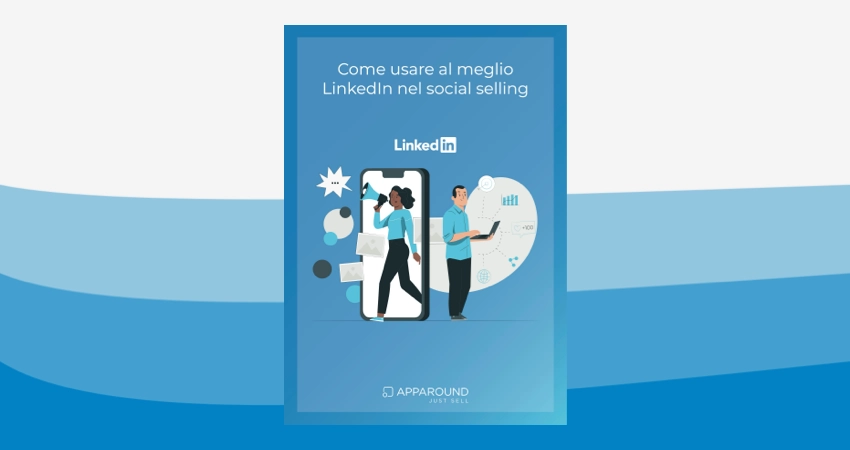Although we are in the middle of the era of sales automation, the attention to sales techniques shows no sign of abating. The reason is easy to understand: technology is a fundamental support for sales activities, but cannot take the place of understanding and providing what your potential customer wants, which is a purely human factor.
Even though this ability has long been considered a gift of nature rather than a learned skill confusing the professionalism of the seller with what can be an innate persuasive ability should not be discounted. The truth is that sales techniques are learned, perfected and, if supported by the right spirit and a high level of technological equipment, they can guarantee unthinkable results.
What is meant by sales techniques?
It is difficult to give a clear definition of sales techniques. In fact, it is the way in which the seller manages the relationship and the negotiation with the customer in order to maximize the success of his business. That is, to sell more. The simple textbook definition is enough to understand how strong the link is between sales techniques and the study of human behavior, communication methods, psychology and even marketing.
Sales techniques are many, and are studied and codified in a precise way. The literature on the subject, if it is not infinite, is very close. Yet, no sales strategy is set in stone and, above all, there is always a need to adapt it to the specific situation. It is quite clear that there is no effective sales technique for all situations, nor that it is possible for the individual seller to become familiar with one of them and then apply it mechanically to all negotiations. The techniques do not explain precisely what to do or, even more analytically, what to say, but what kind of bond to build, how to place oneself within the negotiation, what objective to pursue in each of the phases and how to build that trust which, especially in the context of B2B sales, must be present to close the deal.
Difference between sales techniques and processes
Sales techniques and sales processes are two very distinct things and should not be lumped together. The sales process is the end-to-end process that includes all the steps required to turn a prospect into a customer.
To understand this statement correctly, it is necessary to take a small step back and frame the activity of the sales team in relation to marketing, in the hope that there is some form of coordination between the two paths. Marketing deals with, among other things, lead generation, i.e. acquiring contacts potentially interested in the company’s products or services. These contacts, who are then scored as part of the qualification activities, are then reached out to by the sales team which proceeds to organize meetings and eventually to finalize the deal. This second part of the activity, which also consists of several progressive phases, is what is defined as the sales process and which serves, in fact, to transform a prospect into a customer and, then, to keep it that way.
It is therefore clear that sales techniques are a different thing, a different concept, since they are not part of the process, they are not a phase of it, but are, in fact, the way in which it is carried out in order to optimize it and, above all, to maximize its results.
The pillars of sales strategies
It has already been said, and it is reiterated here too, that one of the main skills of sellers is to adapt sales techniques to concrete circumstances, to the market in which they operate and to the people with whom they work and interact. Literature is full of sales techniques manuals: some are based on the aim of surprising the potential customer by providing innovative solutions to difficult problems, while others aim to intercept their needs by asking targeted questions, but any effective sales technique cannot ignore understanding the customer’s requirements, which is also one of the pillars of a successful business.
These two pillars are based on two elements that unite the vast majority, if not all, buyers: the attention span available, which is always shortening, and the information bombardment they are faced with in this new era of smartphones and mobile connections. It is almost impossible for the buyer to present himself in front of the seller without having an already fairly precise idea of the products he will hear about. Maybe they found the information directly, or maybe they were with a competitor previously, or an excellent marketing team managed to get them the information they needed through online advertising. In consideration of this, here are some essential ingredients of any sales technique that you want to define as effective.
1. Know the product, the market and the processes
It is a fact that the seller knows his product. To be competent the seller must know the dynamics of the market and the sales process, in order to anticipate any bottlenecks.
Today, in fact, decisions are rarely made by a single person: a product that, in the context of a large company, involves, for example, human resources, IT and communication, must be offered to all its managers. A good salesperson must know in advance any objections and know how to overcome them, as well as anticipate potential obstacles that may arise in the path that leads to the sale.
2.Simplify sales processes
A good salesperson, regardless of the technique adopted, must simplify everything that can be simplified. Here it has to do with the fact that, usually, the buyer has little time and you have to make sure you use it completely to create that relationship of advice and trust mentioned above. It is not acceptable, in 2020, for sales processes to become extremely complex due to errors, forgetfulness, or because you are not updated on the latest product or variant of the same. Here, help is given by technology and, by examining the end-to-end sales process, by sales automation solutions.
3. Putting the customer at the center
Selling is undoubtedly more difficult than it used to be because whoever we are facing is more competent and demanding. Proposing a product or service is not very effective, much more needs to be done: the personalization of the service, one of the cornerstones of selling to consumers in the retail sector, is also applied in this field. Be careful, however, never to compromise the simplicity of the process: constantly satisfying the customer by adjusting the offer down to the smallest detail and providing an infinite amount of information does not necessarily lead to a good relationship and therefore to a sale. We must ensure that the relationship is customer-centric, but also simple, direct, that provides solutions and does not complicate everything in order to provide a tailor-made solution.
Rather, it is necessary to understand the meaning of the term personalization, which lately is increasingly synonymous with data-driven sales: the history of relationships with the customer, the sales already made in the past, the state of the company and its objectives can form an important information asset. on which to set up and model sales techniques.
4. Customer loyalty
Sales techniques should not be aimed solely at an immediate result, that is, at closing a contract, but to build loyalty and a long-lasting relationship.
In a B2B context, this factor is decisive since the seller is not addressing a huge number of consumers, but a selected pool of business decision makers. Carrying out a negotiation while trying to also build a lasting relationship is a winning combination as it strengthens the bond of trust that is the basis of success. It also justifies the rule, truer even today, that it is much easier to sell to those who are already customers than to win new ones. Conversely, focusing solely on the present act, perhaps forcing something to convert the deal into a sale, could drown present satisfaction with future disappointments.
5. Be proactive
The concept of a proactive seller has recently been gaining much success precisely because of the need for simplification, efficiency and building a relationship of trust between those who buy and those who sell. In fact, the proactive seller poses himself as the one who solves a problem for the buyer and does so by directly proposing a solution: the fundamental point, here, consists precisely in providing a clear recommendation supported by what was said before, or product competence, market and business processes.
6. Understanding Decision Making Mechanisms
Some sales techniques focus on the ways people make decisions, trying to act on them to come to a decision quickly.
With the information bombardment that each of us is subjected to even in the private sphere, there is always a minimum of distrust. In the B2B world it is less marked than in B2C, but in any case it is necessary to break down some initial barriers. The most difficult point is to counteract mistrust, although being aware of its existence allows the seller to prepare in advance.
Since it is difficult for prospects to have a lot of time, an idea is to provide them with relevant information in advance of the meeting using non-invasive means, such as e-mail. It is part of the model to ask for short, non-binding meetings, allowing the seller to understand the point of view, priorities and real needs of the buyer, and on the basis of these to propose concrete, simple solutions, validated by solid data and by a proven implementation process.
7. Asking right and effective questions
Some sales techniques focus on the central role of the questions that the salesperson should ask the potential customer during the meeting, regulating their ways and tones. The aim is to understand not only what the “apparent” problems that the product / service must solve, but also the deeper ones and, perhaps, rooted in the inefficiency of some business process. The final goal is to ensure that, speaking of needs and requirements, the seller is able to get to know the client’s company better, so as to be able to quickly configure a tailor-made offer.
8. Being a reliable and trusted consultant
Today’s buyer is very competent. He is not looking for someone to sell him a product: rather, he needs to be able to rely on the seller’s experience to maximize the yield of the product / service he is purchasing and avoid subsequent errors. For this reason, many sales techniques suggest to the seller to carve out, with a combination of experience and competence, the role of the consultant at 360 degrees, so that the relationship does not end with the sales contract but continues to generate beneficial effects with time.
Selling Techniques: What Not To Do
There are prerequisites for a great sales activity, but also things to avoid as much as possible. Some are, in fact, the opposite of the virtuous behaviors mentioned above. For example, not being particularly knowledgeable about market dynamics, complicating the process by adding inefficiency and productivity problems, as well as adopting a simply “reactive” approach to the needs of one’s customers. In addition, we must try to abandon the cliché that the seller is the one who sells everything to everyone, simply because it is not true and it does not work that way, and carefully avoid anything that shows little “connection” with your company. For example, showing up with outdated brochures, not knowing about the existence of a promotion, making presentations that are not aligned with the company’s communication and so on. All this demonstrates the lack of professionalism of the seller, but also a company behind it with some evident management limitations.
Technology helps sales techniques and has an important impact on the whole process, which, thanks to it has become simpler and much more effective. It is technology that, compared to even just ten years ago, has made sellers and buyers extremely more informed and competent, and it is technology that has brought collaboration between work teams to unthinkable levels, towards data-driven models that affect sales at all levels.
For example, once upon a time it was almost impossible for the sales manager to understand precisely the reasons for the success of some and the failure of others, as well as to define strategies with a greater probability of impact. Not that there were no tools, but in the absence of reliable and manageable data in real time, it was at least difficult to explain certain results, identify patterns or detect techniques with the highest probability of success. By now, any type of relationship with a customer, potential or actual, can be monitored, traced and information essential to the results can be deduced from it. We then talk about sales automation by identifying the complex activities that, within a sales cycle, can be automated to avoid errors, forgetfulness or loss of information.
This concerns the entire sales process, which thanks to CRM, CPQ and systems for the sales force, can be highly digitized and brought to the highest levels of productivity. But what impact does technology have on sales techniques, or the way the process is managed? To understand it, it may be useful to go back over a few paragraphs and reread the pillars of successful sales techniques: here, technology influences them all.
Competence
The premise is that technology and connectivity have made buyers and sellers extremely competent and informed about everything. But not only that: you can deepen the discussion thinking about the fact that today, thanks to technology and mobile tools, it is easier to foster the dialogue between marketing and sales and to ensure that the latter are always updated on company news: new products, variants, updates, small changes, price lists, promotions, all accessible and at a touch on the screen. This is very important for the competence and professionalism of the sellers.
Simplification
As we have seen, simplification is a pillar of any truly effective sales technique. But can the relationship with the customer be “simplified” when it is based on paper catalogs that may not be updated, on price lists that must be confirmed by telephone and on the continuous exchange of information with the headquarters for the authorization of a certain percentage of discount? Thanks to mobile tools and a connectivity that is now always on by definition, an estimate can be set up in a few minutes, even in complex sectors such as utilities or telco, in the absolute certainty that there can be nothing wrong or out of date. Further, the best tools available to the sales force also work offline.
Customer-centricity and proactive approach Customer-centricity
Being able to understand the real needs of the customer and ‘summarize’ them in a targeted offer reduces the distance between the parties and leads to increased sales. Thanks to technology, the seller comes to the appointment already knowing the customer (thanks to the data present in the CRM), but can further shorten the distance by configuring a tailor-made offer as they look on and with the direct collaboration of the customer. Not having to worry about data-entry activities, or having prices and promotions confirmed, the seller can spend all his time developing the relationship with the prospect, adopting that proactive approach which is the foundation of success.
The tools available to the sales force
CRMs, CPQs, sales automation tools and all the tools dedicated to the sales force fall within the macro-category of digital transformation. The first great benefit of these tools lies in making sales activities totally paperless: eliminating paper does not only mean reducing relative costs, but above all automating all processes and data passages. The most advanced and efficient tools not only allow sellers to always be updated on prices, products and news, but completely eliminate the limits of sales productivity that have always conditioned these activities. In particular: errors, missing data, manual procedures, the need for data entry in the company’s management systems and much more, which in addition to compromising sales, generate a strongly negative effect on brand reputation.




